Address any questions or comments regarding this newsletter to the individual authors listed after each article or to its editors, Nathan Johanning, 618-939-3434, njohann@illinois.edu or Bronwyn Aly 618-695-6060, baly@illinois.edu. The Illinois Fruit and Vegetable News is available on the web at: http://ipm.illinois.edu/ifvn/. To receive or be removed from email notification of new postings of this newsletter, contact Nathan Johanning or Bronwyn Aly at the phone numbers or email addresses above.
In This Issue:
Upcoming Programs ((listings for beginning and established growers))
News & Announcements ((New FDA Fact Sheet on Dropped Covered Produce, Filing Pesticide Drift Complaints))
Regional Reports ((west central Illinois, St. Louis Metro East, southern Illinois, Dixon Springs))
Fruit and Vegetable Pest Management ((Pumpkin Pest Management Update))
Upcoming Programs
Check the Illinois SARE calendar for a full list of programs and links for registration.
http://illinoissare.org/ and http://illinoissare.org/calendar.php
Also see the University of Illinois Extension Local Food Systems and Small Farms Team’s website at:
http://web.extension.illinois.edu/smallfarm/ and the calendar of events at http://web.extension.illinois.edu/units/calendar.cfm?UnitID=629.
- 2019 Southern Illinois Summer Twilight Meeting Jackson County Extension Office 402 Ava Rd. Murphysboro, IL, Monday, August 19, 2019 at 6 p.m. Join us as we tour research trials and discuss crop management including high tunnel production of vegetables & cut flowers, no-till tomato production & variety selection, asparagus production, nutrient management in pumpkins, and cover crops. This program is provided at no cost but pre-registration is appreciated. Please register online at http://web.extension.illinois.edu/ghhpsw/ or by calling 618-687-1727 no later than Friday, August 16, 2019. For more information please contact Nathan Johanning, njohann@illinois.edu; 618-687-1727 or Bronwyn Aly, baly@illinois.edu; 618-252-8391.
- 2019 HerbFest, Saturday, August 24, 2019 from 9:00 am to 3:00pm. The Illinois Herb Association will host the 2019 HerbFest at the Reddick Mansion & Gardens, 100 West Lafayette Street, Ottawa, Illinois on Saturday, August 24. Join us for a day filled with informational speakers, workshops, exhibitors, and a self-guided tour of the Reddick’s gardens. Following the 2019 HerbFest, consider taking a self-guided tour of the beautiful downtown Ottawa gardens. The HerbFest agenda will be placed on our Facebook page as it is completed. Click on and “LIKE” us at https://www.facebook.com/IllinoisHerbAssociation for up-to-date information. For additional information or to register, contact Charlene at 309-557-2107 or Cblary@ilfb.org. For information regarding Reddick Mansion, click here: http://reddickmansion.org/.
- Dekalb County Farm Stroll, Saturday, August 17, 2019 from 12p.m.-5p.m. Free self-paced tours of diversified family farms including Beeutiful Bounty Farms, Waterman Winery, Walnut Grove Vocational, Whiskey Acres Distilling & Co., Gehrke Farmstead, & Theis Farms.
- Farm Tour - Bronkberry Farms, Wednesday, August 28, 2019, 9:00 A.M. to Noon, 18061 S. Bronk Road, Plainfield, Illinois 60586. The Farms grow vegetables and fruit including over 600 apple trees on 25+ acres. This season will be the first time apples will be produced. Chickens are also raised, and farm fresh eggs are sold. Read more about Bronkberry Farms here: https://bronkberryfarms.com/. The event is free, but please register online by August 26 at https://web.extension.illinois.edu/registration/?RegistrationID=20728. For more info, email James Theuri: jtheu50@illinois.edu or call 815-933-8337.
- On-Farm Readiness Review Field Days. August 28, 2019 PrairiErth Farm 2047 County Road 2100th Street, Atlanta, IL AND August 29, 2019 Flamm Orchards 8760 Old Highway 51 North Cobden, IL 9:00 a.m. to 2:30 p.m. with lunch provided. These workshops offer a chance to build a relationship with the FDA and see the FSMA: Produce Safety Rule in action on-farm to help you better prepare your operation for these requirements. This is a FREE workshop, but seating is limited. To register visit: www.ilfb.org/OnFarmReady. For any further information contact Raghela Scavuzzo at rscavuzzo@ilfb.org or 309)557-2155.
- Ogle County Farm Stroll, Sunday, September 8, 2019 from 12p.m.-5p.m. Free self-paced tours of diversified family farms. https://web.extension.illinois.edu/units/event.cfm?EventID=81661&UnitID=463
- Guiding Farmers to Legal Resilience, Farm Common's workshop, Thursday September 19th, 2019 at the McLean County Farm Bureau Building in Bloomington. FREE full-day interactive farm law training workshop for agricultural service providers in Illinois. We invite you to join us for this day of farm law learning! For more info + to register, click here.
- Boone County Farm Stroll, Sunday, October 6, 2019 from 12 p.m.-5 p.m. Free self-paced tours of diversified family farms. https://web.extension.illinois.edu/units/event.cfm?EventID=81622&UnitID=463
- 2020 Illinois Specialty Crops Conference, January 8-10, 2020, Springfield, IL. Save the date!!!! https://www.specialtygrowers.org/2020-save-the-date . More information to follow later in the year but mark your calendars now and plan on attending the pre-conference workshops, conference programming, trade show, and annual association meetings!
News & Announcements
New FDA Fact Sheet on Dropped Covered Produce
FDA just published a fact sheet on dropped covered produce. There is an English version and a Spanish version.
You can access the fact sheet by heading to the Produce Safety Rule landing page (https://www.fda.gov/food/food-safety-modernization-act-fsma/fsma-final-rule-produce-safety), and looking at the bottom of the tab titled “Assistance for Industry”.
You can also access the fact sheets directly though the links below:
Laurie George (618-548-1446; ljgeorge@illinois.edu)
Filing Pesticide Drift Complaints
Just as a reminder in the unfortunate case that you suspect you observe pesticide drift on your farm below is the information on how to file a complaint.
If you believe your property has been damaged by pesticide misuse, call the IDOA's Bureau of Environmental Programs at 1-800-641-3934 (voice and TDD) or 217-785-2427 for a complaint form or online at:
https://www2.illinois.gov/sites/agr/Pesticides/Documents/pesticidemisusecomplaintform.pdf. Complaints must be received by the IDOA within 30 days of the incident or within 30 days of when the damage was first noticed. Complaints filed after that will be kept on record, but no administrative action will be taken.
Regional Reports
From west central Illinois (Macomb)… July was a dry month. Macomb saw 0.4 of an inch of rain for the month. Last night on August 5, we finally got some rainfall measuring 0.21 of an inch. Bush beans have been sitting in the field, putting on a steady flower show, but little pod development. Hopefully, with this new rainfall, we will see beans, and other crops moving along.
Unirrigated tomatoes in the field look great, minus the small fruit size. I believe this is mostly due in part again to the low amount of rain, which means less soil splash and fewer disease opportunities. With the rain, growers are watching closely for splitting tomatoes.
There have been many crop failures this year. After visiting a grower and seeing the difference in early versus late-planted crops, it is incredible to see the plants going in the ground almost a full month later as they have outgrown those planted earlier in the year.
In terms of pests - Japanese beetle damage seems to be lessening. Squash bugs have been on the increase. Our squash blooms have been loaded with pollinators, so I have been quite cautious with my spraying. Certain varieties of cucumbers are showing symptoms of possible downy mildew. Slug damage on sweet potatoes hasn’t slowed their growth.
Fall crops should be getting seeded in flats for transplanting or going in the ground for direct seed. On the other hand, if you are behind like me, seed should be in hand with the hope of getting it planted.
Chris Enroth (309-837-3939; cenroth@illinois.edu)
From the St. Louis Metro East… Temperatures have finally dropped into what would be considered average for this time of year, low 90’s during the day and low 70’s at night. Humidity is high and rain has been hit or miss.
Peaches are in the ‘Bounty’ window, soon to be in ‘Cresthaven.’ With all the rain, some young peach planting are showing nitrogen stress. It can be site and cultivar specific in terms of severity. Some symptomology is due to ‘wet feet,” but much is due to loss of applied nitrogen, especially if non-stabilized urea was used early in the season. This may start out as just a lightening in the green of the leaves. More advanced symptoms develop as red spots that eventually shothole, looking somewhat like bacterial spot. The necrosis or death of the growing point can be easily missed without close observation if the cultivar doesn’t strongly show the other symptomology. Normally, additions of nitrogen are not recommended after the middle of July. Any new growth that doesn’t harden off may be winter injured, so the goal is not to promote new growth late in the season. This case is an exception. Fertility status is linked to winter hardiness, so a nitrogen deficient plant may suffer additional winter injury compared to a tree at optimal status.
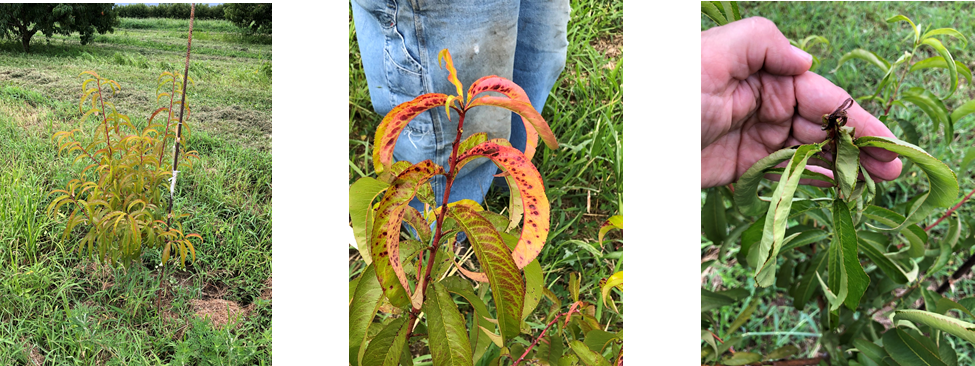
Nitrogen deficiency symptoms on peach include yellowing of leaves, reddish spots that shot hole as deficiency increases, and death of growing point. From left to right: 'Flamin'Fury PF5D Big,' Autumnstar and Coralstar. Photo: E. Wahle
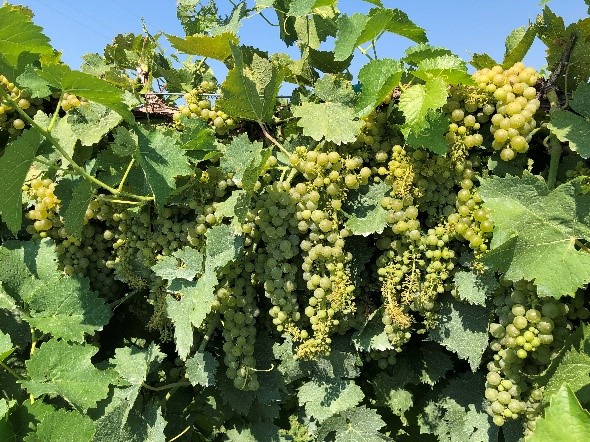
Vidale' at 10.2 °Bx. Photo: E. Wahle
Nitrogen is a very mobile nutrient, so the recommendation at this time would be low enough to improve the status of the plant without promoting excessive growth. In the case above, 40 lbs/N/Ac was recommended in the dripline, due to the severity of symptoms.
Sampling for harvest readiness just got started for the majority of grapes grown for wine. Samples taken at a site in Jersey County showed Vignoles at 14.2 °Bx with a pH of 2.89, Vidal at 10.2 °Bx with a pH of 2.75, and Chardonel 14.4 °Bx with a pH of 2.72. By way of comparison, °Bx are usually between 18 and 24 at harvest, depending on variety and wine style; and pH for white grapes at harvested should be between 3.1 to 3.3, with red grapes slightly higher between 3.3 to 3.5.
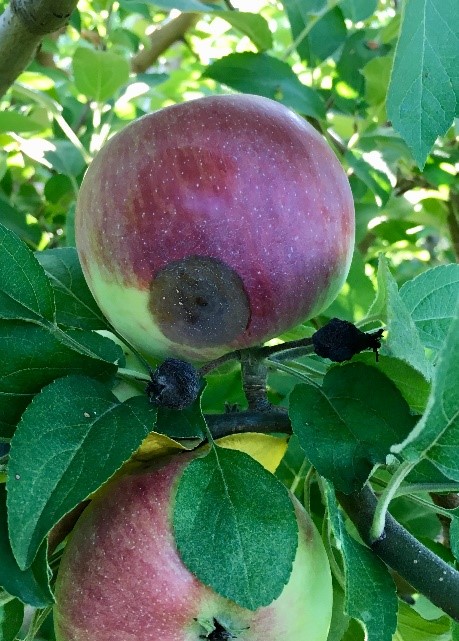
Photo: Grower supplied, anonymous
Bitter rot of apple is starting to make itself known in more susceptible cultivars like Fuji, Golden Delicious and Empire. One of our growers sent me a picture of Empire with bitter rot, entitling it “Poster Child for Bitter Rot.” Notice the lesions directly opposite of an infected mummy? Any mummy left in the orchard has a potential to splash disease propagules on to fruit, making the combination of sanitation and effective fungicide applications critical in the management of this disease. All of the disease material should be destroyed (buried or burned) if at all possible, or at the very least moved downwind and away from the orchard.
Elizabeth Wahle (618-344-4230; wahle@illinois.edu)
From southern Illinois... It has been the typical hot, dry summer weather. Temperatures have been in the upper 80s to low 90s with a lot of humidity. We have had a few periodic fronts that have come through and eleviated some of the humidity for a few days. As far as rainfall we have been dry here in Murphysboro for over a week, however, Monday (8/5) a fairly wide band of pop up stroms crossed through the area but missed us in Murphysboro. For those like us that missed that rain, some precipication would be appreciated. The forecast ahead shows more rain chances later this week, but continued average summer temperatures.
Peach harvest continues with vareities Cresthaven and the latter part of Belle of Georgia. Summer vegetable harvest continues with a full range of crops. We have been seeing quite a few catipillar pests on tomates especially fruitworms and yellow striped armyworms. There are many products that can be used to help control these pests including Dipel (OMRI), Sevin and many of the pyrethroids. For more details on these pests or others consult the Midwest Vegetable Production Guide. Here at my office we have pumpkins taking off in mulitple trials including a variety trial for some hullless seed pumpkins. For those that like roasted pumpkin seeds, especially if you make value added products, this is something I would encouage you to at least look into. I’ll report more as we get closer to trial harvest.
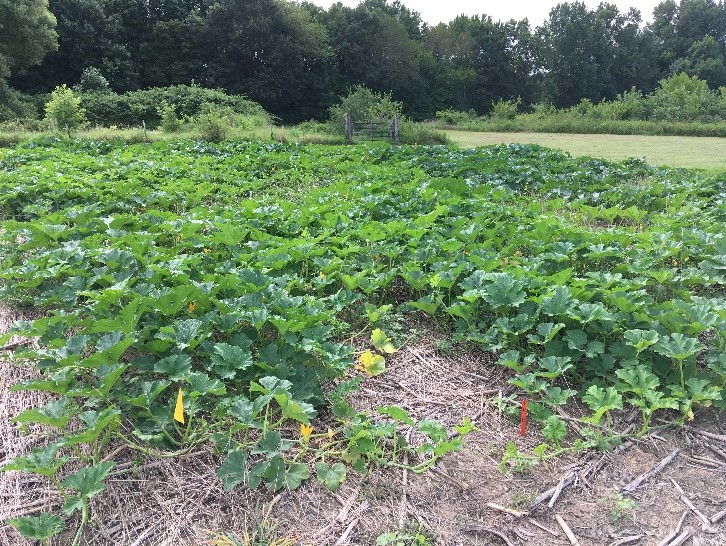
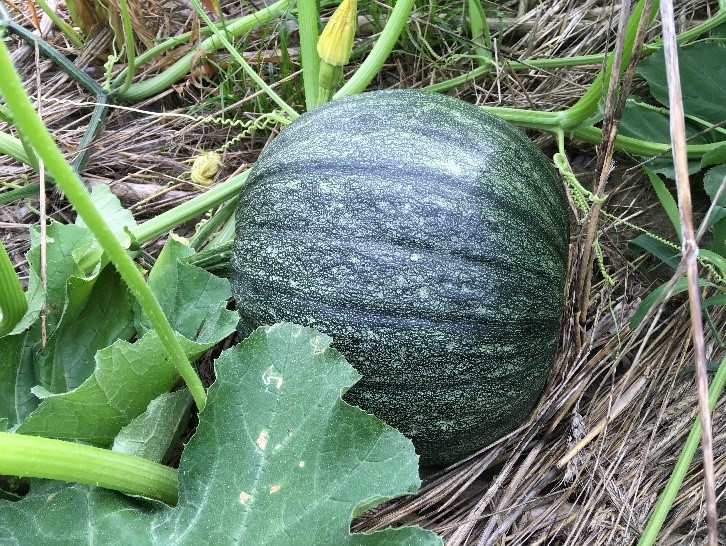
Hulless seed pumpkin variety trial at the Jackson County office (left). Fruit set one of the varieties, HSC 151 (right). Photos: N. Johanning
It is time to keep an eye on pumpkin pests. I have some notes later in this issue detailing some things to scout for in pumpkins. My pumpkin crop is looking good. Last week I gave them a sidedress application of about 60 lb nitrogen per acre with ammonium nitrate. Although harder to find, it is still available. Ammonium nitrate is still one of my preferred dry N sources especially for surface applications like this, due to its stability from nitrogen loss (mainly volatilization) and it being a readily plant available form of nitrogen containing approximately balanced proportions of the ammonium and nitrate forms of nitrogen.
Now is also the time to think about planting some fall vegetables. In the next few weeks in this region, it’s time to down here planting things like fall crops of carrots, green beans and peas and set out transplants of cole crops!
We hope to see some of you at our Twilight Meeting Monday, August 19, 2019 at 6 p.m. at my office in Murphysboro. We will be discussing all of the current research (pumpkin, cover crop, tomato, asparagus, high tunnel & more) and sharing results from last years trial including our tomato variety trial. See the calendar of events above for more details and registration!
Nathan Johanning (618-939-3434; njohann@illinois.edu)
From Dixon Springs Ag Center…We received a very pleasant break from the heat and humidity, with what felt almost like fall, and then back to humidity. A second front which moved through on Monday/Tuesday (July 29/30) brought us about three quarters of an inch of rain and another slight break in humidity. We are continuing to harvest tomatoes, peppers, cucumbers, cut flowers, eggplant, and strawberries two to three times per week. The bell pepper plots set a lot of fruit in the intial flower clusters and we have been in a lull, waiting for the second set of fruit to size. The plants are continuing to set more flowers and some of the plants are approaching 5 feet in height. The production in high tunnels is always quite amazing to me, and I am looking forward to picking peppers that are shoulder high (no bending over).
The oldest high tunnel on site has gone through several major wind events and a few of the bows have been tweeked, making it hard to get the plastic stretched tight across the top. Without wind to help shed rain, water can pool in some of the low spots. This can be a problem as it adds quite a bit of weight to the plastic, causing it to sag further between bows. The rain we received during the day on July 29th was a slow steady event with little wind. This is just a reminder to those with high tunnel plastic that might not be very taunt, to check for sagging, pooling water areas and work to get the water off the plastic. In the series of pictures, Julie has a plastic extendable pole with a brush on the end that she uses to push the plastic up from the inside and drain the water. If the pool of collected water gets too heavy, pushing the pool up to drain may not be an option, in which case, the plastic may need to be perforated and the water allowed to drain through the hole or holes. These sagging low spots in the plastic will also hold snow in the winter, which can be very heavy and cause structural damage to the tunnel. Hence, another reason why reducing additional sagging or stretching from rain events is important.
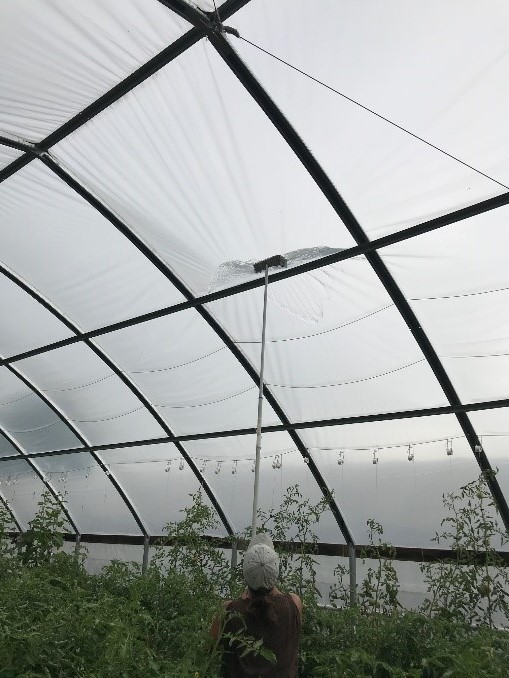
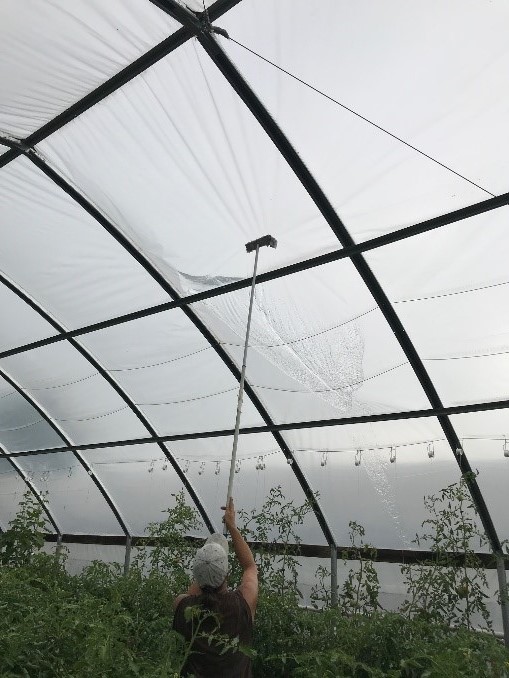
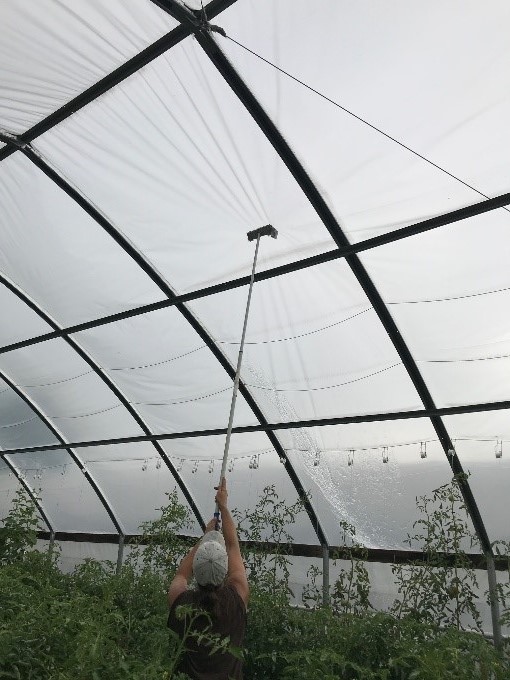
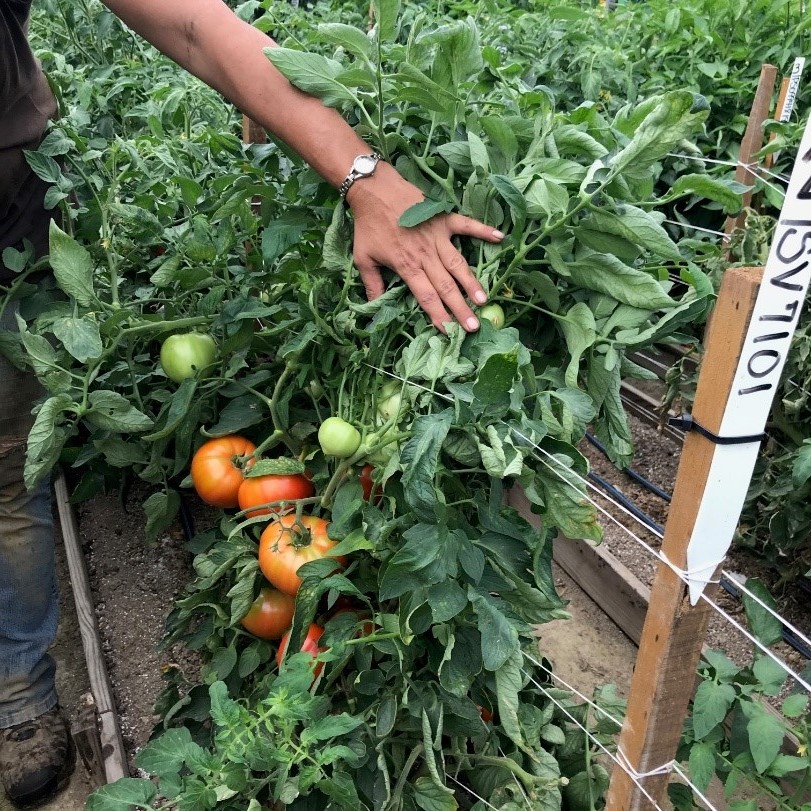
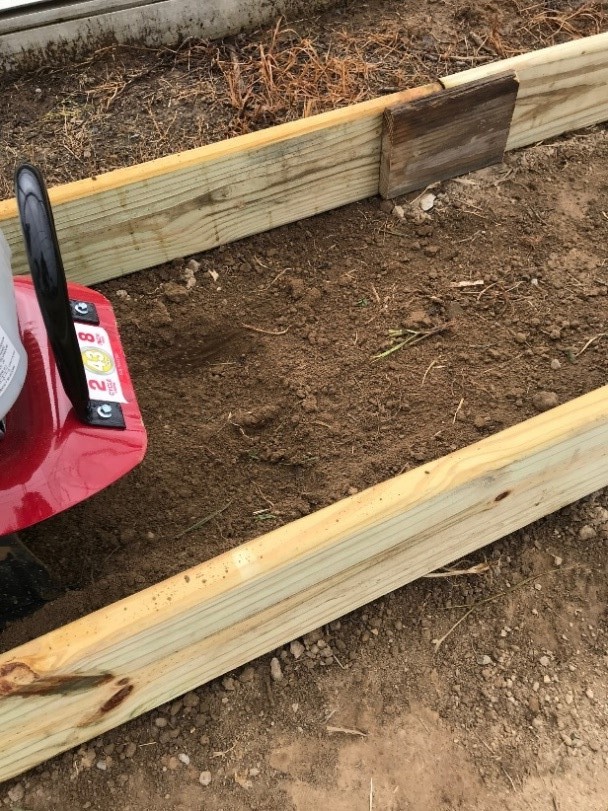
Photos by B. Aly.
In observing the different tomato variety plots, one cultivar that seems to be standing out this year is SV7101. The fruit is of very high quality, large, uniform, with good flavor. From the picture above, you can see the large fruit set from the second cluster for the plant. Also to note, the plant is continuing to set a good number of fruit in the third cluster. Plants seem to produce ample foliage, protecting fruit from sunburn. We are collecting harvest data from these plots, and I look forward to seeing how the numbers compare to my in season observations. And yes, I will be sharing harvest data for both the tomato and bell pepper variety trials from this 2019 season during the winter months, once harvests are concluded and data analysis is complete.
We are working to build and fill new raised beds in the third tunnel at DSAC. In the picture above, we have installed the sides on the raised beds and run the small cultivator inside the bed to work up the soil at the bottom before adding the fill materials. We hope to loosen compaction and allow for better drainage under the beds. The beds were filled with a mixture of composted horse manure (a product that was readily available) and top soil. The mixture was tilled together and beds were filled to the top of the boards (treated 1” x 6” deck boards) and then steamed.
Bronwyn Aly (618-382-2662; baly@illinois.edu)
Pumpkin Pest Management Update
Now is the time of year when pumpkin growers need to be scouting and focus on their mid-season pest management strategies. I have not hit on everything possible, but just a few highlights with some of this information applicable to other crops too. Here are a few pests to watch:
Weeds:
Grass weeds can be sprayed with Select or Poast (or one of the many generics…Arrow, Clethodim 2EC, etc.). These products work best on smaller grasses 4” or less but will control larger grasses. Note these products work by killing the growing point and often even after the plant stops growing you may still see discolor leaves and the plant “hanging on”. This is just how this herbicide mode of action works, but rest assured they are dead. I have a few picture below where SelectMax was sprayed about a week prior. To check, you can see where I have pulled the center out of a giant foxtail and see how the bottom end that was down in the whorl at the growing point is brown and dead. Also, note the characteristic purplish coloration seen on the ends of leaves, especially on foxtails and large crabgrass. This is another sign the herbicide is doing its job. On all of these products note the formulation and adjuvants needed. Product rates and adjuvant recommendations vary with different products and the generics, and both of these things can make or break the results you will see. If you are hand weeding/hoeing note that catching these grasses small is much easier to handle than large. Crabgrass the size pictured below will root at nodes and almost can be impossible to remove by hand easily.
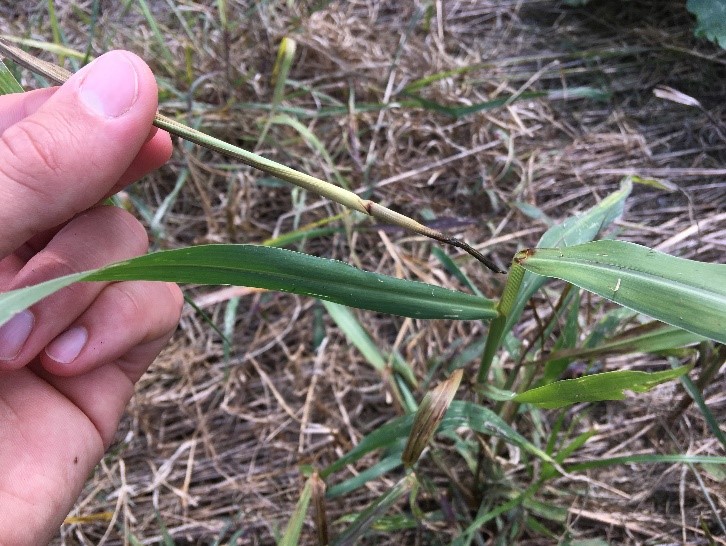
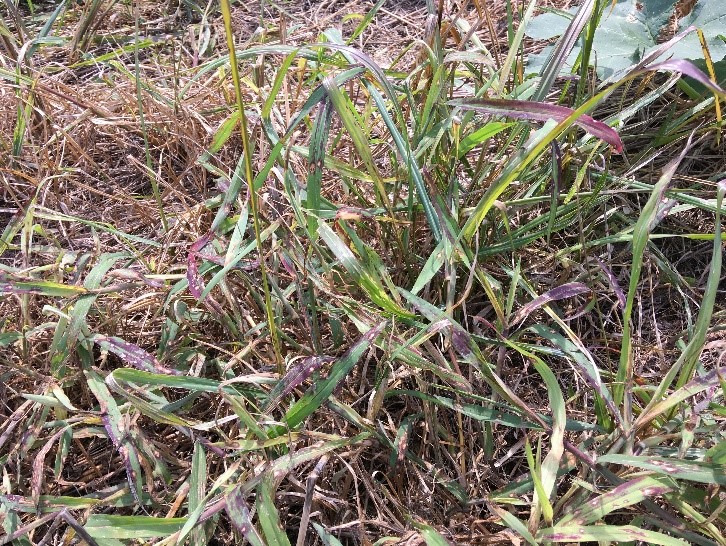
The dead growing point pulled out of a giant foxtail sprayed about a week after spraying with SelectMax (left). See the characteristic purplish color on the end of leaves after a product like SelectMax is applied; seen here on large crabgrass (right) Photos: N. Johanning
For broadleaves, at this point contact herbicides such as Gramoxone or Aim in a backpack sprayer or shielded sprayer would be the best option. I have done this myself especially parts of the field where I have pockets of weeds like morningglory, hophornbeam copperleaf, and prickly sida. If you have cocklebur or yellow nutsedge, Sandea could be an option, but at this point in the season, you would need to direct the spray to avoid contact with pumpkin plants. It is not as injurious as Gramoxone and Aim, but you want to avoid getting it on the plant. Hoeing is can be a good option especially to control small patches and especially taller scattered weeds.
Generally contact control measure like horticultural vinegar and flaming are only effective on very small weeds. Small annual broadleaves can be the easiest to kill with these means, but grasses are much harder to kill because the growing point is at the base of the plant.
REMEMBER even though these weeds might be scattered and not do much this season against your yield they are producing seeds, for some 10s of thousands of seeds. If they are a problem now, adding even more seeds of a weed you struggle with is only going to make things worse in future years.
Diseases:
Now is the time that powdery mildew is coming on if not already. Late July and August is usually when we start to see powdery mildew, and it would be good that pumpkins a protectant spray for disease management. Here are a few pictures of the early stages of powdery mildew. You can see the yellowish spots on the leaf surface, but the real indicator is the white powdery spots on the underside of the leaf below those spots. The underside of leaves and on the vines are usually the first places we see powdery mildew. Refer to an article from the previous newsletter, IFVN 25:12 which refers to all of the current fungicide recommendations from our plant pathologist, Dr. Mohammad Babadoost.

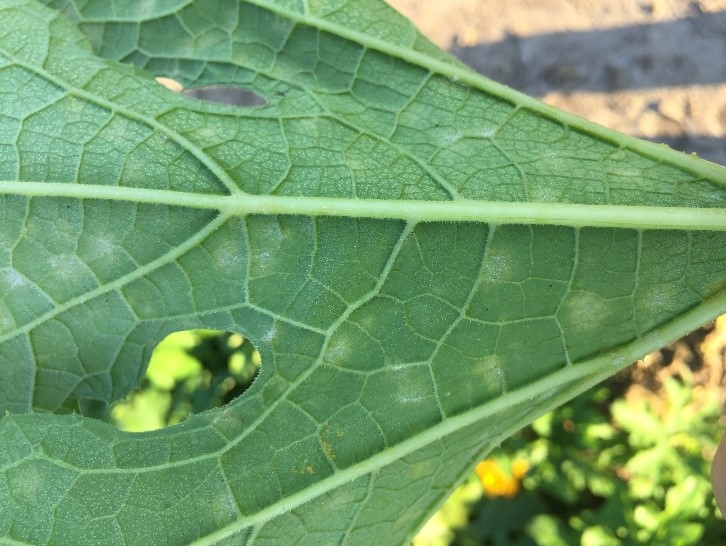
Yellowed spots on pumpkin leaf surface from powdery mildew (left). Looking at the underside of the leaf you can more easily identify powdery mildew by the white powdery spots (right) Photos: Grower Supplied.
Insects:
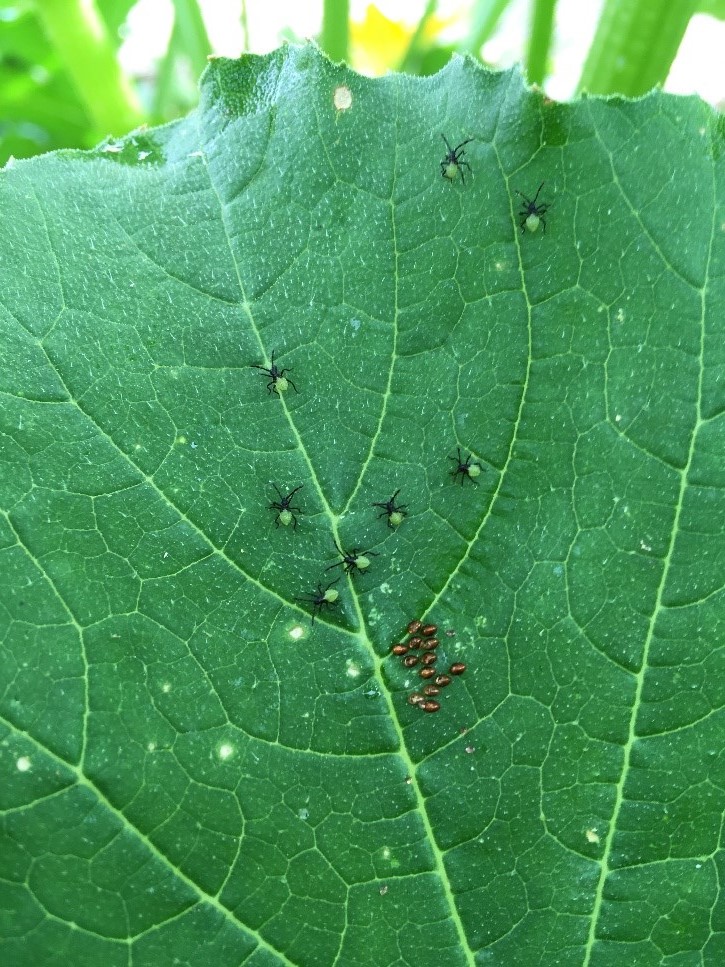
Squash bug nymphs just hatching from eggs on pumpkins. Photo: N. Johanning
Cucumber beetles and squash bugs are the two common insect pests. I have seen some cucumber beetles, however, they have not been in high enough population to warrant and insecticide application. Cucumber beetles are more easily controlled than squash bugs and squash bugs adults are especially difficult. Often the first thing in scouting you might notice is a cluster of small (less than 1/16” diameter) red to bronze eggs laid on the leaf surface or underside. The best time to spray for these insects is right when eggs are hatching. The insecticides are not effective on the eggs, but can kill the young nymphs. The picture show that ideal stage where you can see eggs starting to hatch. A threshold of 1 egg mass per plant is suggested with spraying when eggs hatch as discussed. Generally the pyrethroid insecticides are the best option we have for control. There are limited OMRI approved products that are very effective against this insect. The natural pryrethrins can provide some control but only persist on the foliage for a few hours so timing is very critical and not all eggs hatch at once.
These are just a few things to consider when managing your pumpkin pests mid-season. For any pest management issues and more details on the specific products to apply or practices consult the Midwest Vegetable Production Guide
Nathan Johanning (618-939-3434; njohann@illinois.edu)
Less Seriously
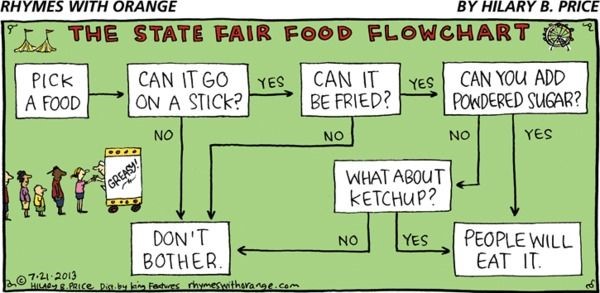
I saw this article online, “15 unique town names in Illinois”, and thought I would take a survey of who lives in, near, or around any of these towns. If you live near one of these towns, shoot back an email to either myself or Nathan and let us know which one. I have been to four of the towns and hadn’t heard of the others.
- Goofy Ridge
- Normal
- Birds
- Oblong
- Muddy
- Sandwich
- Ransom
- Cairo
- Wyoming
- Golf
- Mechanicsburg
- Hometown
- Boody
- Benld
- Bone Gap
University of Illinois Extension Specialists in Fruit and Vegetable Production & Pest Management
Extension Educators – Local Food Systems and Small Farms |
||
Bronwyn Aly, Gallatin, Hamilton, Hardin, Pope, Saline, and White counties |
618-382-2662 |
|
Katie Bell, Franklin, Jackson, Perry, Randolph, & Williamson counties |
618-687-1727 |
|
Sarah Farley, Lake & McHenry counties |
847-223-8627 |
|
Nick Frillman, Woodford, Livingston, & McLean counties |
309-663-8306 |
|
Laurie George, Bond, Clinton, Jefferson, Marion, & Washington counties |
618-548-1446 |
|
Zachary Grant, Cook County | 708-679-6889 | |
Doug Gucker, DeWitt, Macon, and Piatt counties |
217-877-6042 |
|
Erin Harper, Champaign, Ford, Iroquois, and Vermillion counties |
217-333-7672 |
|
Grace Margherio, Jackie Joyner-Kersee Center, St. Clair County |
217-244-3547 |
|
Grant McCarty, Jo Daviess, Stephenson, and Winnebago counties |
815-235-4125 |
|
Katie Parker, Adams, Brown, Hancock, Pike and Schuyler counties |
217-223-8380 |
|
Kathryn Pereira, Cook County |
773-233-2900 |
|
James Theuri, Grundy, Kankakee, and Will counties |
815-933-8337 |
|
Extension Educators – Horticulture |
||
Chris Enroth, Henderson, Knox, McDonough, and Warren counties |
309-837-3939 |
|
Richard Hentschel, DuPage, Kane, and Kendall counties |
630-584-6166 |
|
Andrew Holsinger, Christian, Jersey, Macoupin, & Montgomery counties |
217-532-3941 |
|
Extension Educators - Commercial Agriculture |
||
Elizabeth Wahle, Fruit & Vegetable Production |
618-344-4230 |
|
Nathan Johanning, Madison, Monroe & St. Clair counties |
618-939-3434 |
|
Campus-based Extension Specialists |
||
Kacie Athey, Entomology |
217-244-9916 |
|
Mohammad Babadoost, Plant Pathology |
217-333-1523 |
|